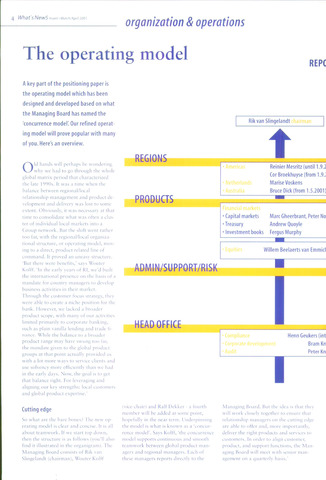The operating model
m
organization operations
REPC
REGIONS
PRODUCT!
ADMIN/SUPPORT/RISK
HEADOFFI
4 What'sNewS Insert March/April 2001
A key part of the positioning paper is
the operating model which has been
designed and developed based on what
the Managing Board has named the
'concurrence model'. Our refined operat
ing model will prove popular with many
of you. Here's an overview.
Cutting edge
Rik van Slingelandt
Reinier Mesritz (until 1.9.2
Cor Broekhuyse (from1.9.i
Marise Voskens
Bruce Dick (from 1.5.2001)
Capital markets Mare Gheerbrant, Peter No
•Treasury AndrewQuoyle
Investment books Fergus Murphy
Willem Beelaerts van Emmicl
Flenn Geukers (int
Bram Kri
Peter Kn
O ld hands will perhaps be wondering
why we had to go through the whole
global matrix period that characterized
the late 1990s. It was a time when the
balance between regional/local
relationship management and product de-
velopment and delivery was lost to some
extent. Obviously, it was necessary at that
time to consolidate what was often a clus
ter of individual local markets into a
Group network. But the shift went rather
too far, with the regional/local organiza-
tional structure, or operating model, mov-
ing to a direct, product related line of
command. It proved an uneasy structure.
'But there were benefits,says Wouter
Kolff. 'In the early years of RI, we'd built
the international presence on the basis of a
mandate for country managers to develop
business activities in their market.
Through the customer focus strategy, they
were able to create a niche position for the
bank. However, we lacked a broader
product scope, with many of our activities
limited primarily to corporate banking,
such as plain vanilla lending and trade fi-
nance. While the balance to a broader
product range may have swung too far,
the mandate given to the global product
groups at that point actually provided us
with a lot more ways to service clients and
use solvency more efficiently than we had
in the early days. Now, the goal is to get
that balance right. For leveraging and
aligning our key strengths: local customers
and global product expertise.'
So what are the bare bones? The new op
erating model is clear and concise. It is all
about teamwork. If we start top down,
then the structure is as follows (you'11 also
find it illustrated in the organigram). The
Managing Board consists of Rik van
Slingelandr (chairman), Wouter Kolff
t
I
(vice-chair) and Ralf Dekker - a fourth
member will be added at some point,
hopefully in the near term. Underpinning
the model is what is known as a 'concur
rence model'. Says Kolff, 'the concurrence
model supports continuous and smooth
teamwork between global product man
agers and regional managers. Each of
these managers reports directly to the
Managing Board. But the idea is that they
will work closely together to ensure that
relationship managers on the cutting edge
are able to offer and, more importantly,
deliver the right products and services to
customers. In order to align customer,
product, and support functions, the Man
aging Board will meet with senior man
agement on a quarterly basis.'

